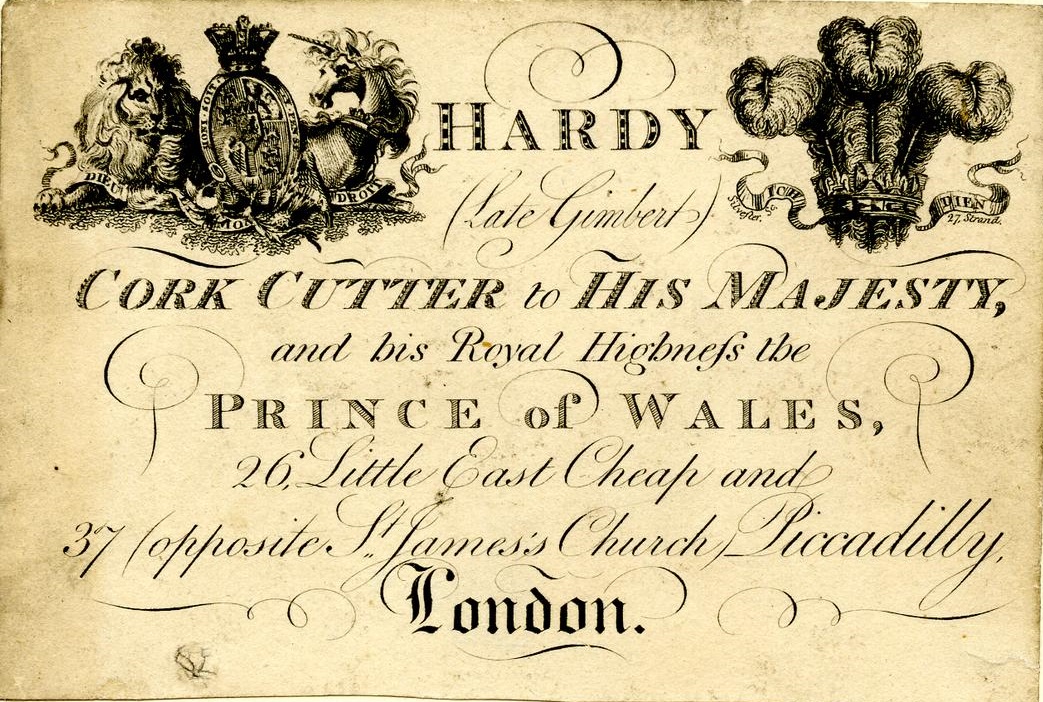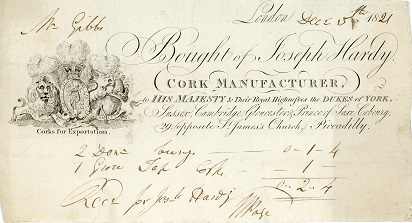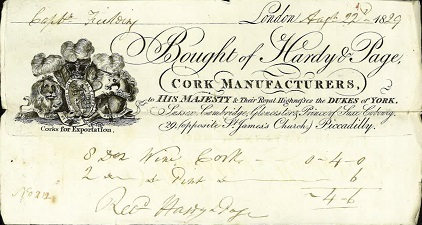| Home |
| Cork-Cutters by Royal Appointment |
Previous: Cork-Cutters by Royal Appointment: Gimbert and Swingland
Hardy and Page
After the death of Richard Gimbert, the new proprietor of the Piccadilly cork-cutting shop became Joshua Hardy who was already established at 26 Little Eastcheap. He continued to provide cork-cutting services at both locations. The 1807 Post Office London Directory described Joshua Hardy, ‘cork-manufacturer to his Majesty and the Prince of Wales, 37 Piccadilly & 26 Little Eastcheap’ (1).
The Hardy trade card was decorated with, at upper left, the Royal Arms, and, at upper right, the badge of the Prince of Wales depicted by the plume of three ostrich feathers.
Trade Card, London, early 1800s
| |
 | |
from
Heal Collection,
British Museum  . .
|
In the early nineteenth century the term ‘cork manufacturer’ appears to have been introduced as an alternative to ‘cork-cutter’. The trade card described Hardy as a cork-cutter while the listing in the Post Office London Directory labelled the Hardy business as cork manufacturer.
In 1785 Joshua Hardy became the new manager of the London cork-cutter shop at 26 Little Eastcheap. He took over from William Key who was listed as the cork-cutter at 26 Little Eastcheap in editions of Kent’s London Directory published in the early 1780s. William Key wrote his will on 28 July 1785 and, a few weeks later, he added a codicil stating: ‘since the signing [of the will] I have sold my stock in trade to Mr Joshua Hardy and let him my house for the term of the lease’ (2). William Key passed away later in the year.
Before his move to Little Eastcheap, Joshua Hardy plied his trade as a cork-cutter on the south side of the River Thames in John Street, Horsleydown, Southwark (3). No details have been traced about his early life and family background.
Joshua Hardy was a member of the Pattenmakers’ Company of London; he supervised a succession of apprentices over the years (4).
Joshua Hardy was buried on 6 May 1808 at St George’s Church, Hanover Square (5) – just ten days before the 20th birthday of his son Joseph. In his will, Joshua expressed the ‘intent that my business of a cork-cutter may be carried on for the benefit of my family and I direct that my said wife [Catherine Hardy] and my son Joseph Hardy [step-son of Catherine] . . . . shall immediately after my decease enter into regular articles of copartnership during their joint lives’ (6).
As Joshua had hoped, the Hardy cork-cutting business continued under the joint direction of Catherine and Joseph until Catherine’s death in 1820. The Post Office London Directory compiled for 1811 had an entry:
C. & J. Hardy, cork-manufacturers to his Majesty,
and his R.H. the Prince of Wales,
26 Little Eastcheap and 37 Piccadilly
The Hardy trade card in the British Museum collections may be from the time of either Joshua Hardy or his successors C. & J. Hardy.
The wedding of Joseph Hardy and Mary Clarke Southard took place on 17 March 1811 at St John’s Church, Church Row, Hampstead (St John-at-Hampstead). At some point, the Hardys made their family home in Hampstead, a community a few miles north of Piccadilly. The only son of Joseph and Mary Hardy, named John Forbes Hardy, was baptised on 27 November 1816 at the church of St John-at-Hampstead (his middle name, Forbes, was the maiden name of his maternal grandmother). At the same church, Catherine, aged 62, the widow of Joshua Hardy, was buried on 14 June 1820 (7).
Joseph Hardy gave up the tenancy of both 26 Little Eastcheap and 37 Piccadilly – according to the annual publications of the Post Office London Directory, in the decade of the 1820s, Joseph Hardy ran his business as a cork-cutter at the address 29 Piccadilly.
Receipted bill dated London, 5 December 1821
| |
 | |
| Collection of the author. |
The bill, shown above, from Joseph Hardy, cork manufacturer, issued in December 1821, displayed the Royal Arms with a list of names of members of the royal family to recognize that Hardy’s firm was an official supplier to the Households of His Majesty King George IV (ascended the throne on the death of his father, King George III, on 29 January 1820); three of the king’s brothers: the Duke of York (Prince Frederick), the Duke of Sussex (Prince Augustus Frederick) and the Duke of Cambridge (Prince Adolphus); the king’s brother-in-law the Duke of Gloucester (Prince William Frederick, the husband of Princess Mary); and the king’s son-in-law Prince of Saxe Coburg (Leopold, the husband of Princess Charlotte who died in childbirth in 1817).
The 1821 bill itemized the sale of cork stoppers known as bungs and tap corks. This was a small order as the account showed that two dozen bungs and one score (20) tap corks were purchased for a total charge of 2 shillings and 4 pence.
The final line of the bill appears to note that Hardy’s sales manager was ‘W Page’. By the end of the decade William Page was promoted to business partner and the name of the firm became ‘Hardy & Page’.
William Page, born at Maidstone, Kent in 1777, was eleven years older than Joseph Hardy. In September 1791, at the age of fourteen, he enrolled as an apprentice in London to Joseph’s father, Joshua Hardy (8). William Page was admitted as a member of the Pattenmakers’ Company of London in September 1800 (9).
His daughter Elizabeth Page, born 26 June 1815, was baptised on 17 September 1815 at St James’s Church, Piccadilly. In the baptism record the family home address was stated as Vine Street. At this time, C. & J. Hardy cork-cutters operated at 37 Piccadilly on the north side of Piccadilly near the cross street of Swallow Street which connects to Vine Street (10). The close proximity of his home to the business premises of C. & J. Hardy suggests that William Page was then an employee of the firm. Possibly his entire career was devoted to the Hardy cork-cutter business.
The bill below, from Hardy and Page, dated 1829, was saved in the accounts of Captain Charles Feilding and his wife Lady Elisabeth Feilding for their London residence in Sackville Street. Sackville Street runs north from Piccadilly, near where the shop of Hardy and Page was located. The bill lists a charge of four shillings for eight dozen wine corks.
Receipted bill dated London, 22 August 1829
| |
 | |
| Wiltshire and Swindon Archives, Reference: 2664/2/5B/113. |
At the beginning of the 1830s, Hardy and Page relocated their business next door to 28 Piccadilly.
George IV ruled as King until his death in June 1830 when William IV acceded to the throne. The Morning Advertiser, 29 May 1832, reported on the celebrations for the birthday of King William IV, from the previous day, that included a description of the spectacular gas-illuminations for the evening that were presented by individual clubs, hotels, and shops in the area surrounding Piccadilly. It was noted that, on Piccadilly, ‘Messrs. Hardy and Page, cork-manufacturers’ displayed a ‘projecting crown’.
The ceremonies for the coronation of Queen Victoria, on Thursday 28 June 1838, featured a public procession with the Queen travelling inside the Gold State Coach:
The route was designed to allow as many spectators as possible to view the procession. It followed a roughly circular route from the newly completed Buckingham Palace, past Hyde Park Corner and along Piccadilly, St James’s Street, Pall Mall, Charing Cross and Whitehall, to Westminster Abbey. (11)Although the Royal procession turned off Piccadilly before reaching the shop of Hardy and Page, possibly Joseph Hardy, William Page and their families celebrated as spectators along the route not far from the shop.
Hardy and Page operated a cork factory located at Great Peter Street, to the south of St James’s Park. The Morning Post, London, 16 October 1840 reported:
| Fire – Yesterday morning, at about eight o’clock a most alarming fire broke out in the extensive cork manufactory of Messrs. Hardy and Page, which is situated at the back of Great Peter Street, Westminster. There was a good supply of water, and, by the exertions of the fire brigade, all danger was over by ten o’clock. The value of the cork on the premises was stated to be 2,000l., a great deal of which is burnt or greatly damaged. The manufactory itself has suffered great injury, but the adjoining property has not been touched. Messrs. Harvey [Hardy] and Co. are insured. |
The end of the partnership of Hardy and Page was announced in
The London Gazette,
|
Notice is hereby given, that the Partnership heretofore existing between
us the undersigned, Joseph Hardy and William Page, in the business of
Cork Manufacturers, carried on at Dated 18 August 1849. |
This appeared to mark the retirement of both William Page and Joseph Hardy.
It may have been expected that John Forbes Hardy would become a Piccadilly cork-cutter like his father Joseph and grandfather Joshua Hardy. However, John did not enter the mercantile world of London – he trained to become an artist.
The cork-cutter business at 28 Piccadilly came under the new management of ‘French & Butler’.
William Page died in his 75th year and was buried on 13 August 1851 at Brompton Cemetery, London (12). He was survived by his wife Mary, son Joseph Edward Page, and two married daughters: Elizabeth Hoare and Esther Rebecca Frame.
In the 1851 census, Joseph Hardy, living with his wife Mary in Hampstead, reported his occupation as ‘proprietor of houses’. By the time of the 1861 census, Joseph and Mary Hardy had moved to Worthing, a seaside town on the south coast of Sussex.
| Next: | Cork-Cutters by Royal Appointment: French and Company |
| and | |
| John Forbes Hardy (1816–1906), Artist |
General References
Databases, with browsable document images, hosted by Ancestry online:
- Census records, The National Archives.
- London Directories, London Metropolitan Archives and Guildhall Library.
- London parish registers, London Metropolitan Archives:
- Baptisms, Marriages and Burials, 1538–1812
- Marriages and Banns, 1754–1932
- Deaths and Burials, 1813–2003
- Westminster parish registers, City of Westminster Archives Centre.
Online newspaper archives:
- British Library Newspapers, hosted by Gale, part of Cengage Group.
- The British Newspaper Archive, hosted by FindMyPast.
- The Gazette
 .
.
Notes
(1) Post Office London Directory (London Directories, Ancestry online).
(2) The will of William Key, cork-cutter of St Andrew Hubbard, City of London, was probated on 24 December 1785 (PCC will, National Archives).
(3)
Fire Insurance record (London Metropolitan Archives online catalogue,
reference code: CLC/B/192/F/001/MS11936/329/505413) Date: 3 June 1785;
Insured: Joshua Hardy, John Street, Horsleydown, Southwark, cork-cutter;
Other property mentioned: 18 Pickleherring, Southwark.
(4) Transcribed apprentice records of the Pattenmakers’ Company in London Apprenticeship Abstracts, 1442–1850, FindMyPast online database. A freedeom admission record dated September 1800 for William Page, one of Hardy’s apprentices, confirms that Joshua Hardy of the Pattenmakers’ Company was a cork-cutter by occupation (London Metropolitan Archives online catalogue).
(5) Westminster parish registers, Ancestry online.
(6) The will of Joshua Hardy, cork-cutter of Piccadilly, London, dated 12 April 1808, was probated on 12 May 1808 (PCC will, National Archives). His son Joseph Hardy, born on 16 May 1788, was baptised at St Michael’s Church, Queenhithe, London.
(7) The Hampstead burial record does not identify Catherine Hardy as the widow of Joshua Hardy to confirm the family connection (London parish registers, Ancestry). However, Catherine’s death in 1820 appears likely – the business C. & J. [Catherine and Joseph] Hardy was listed in the 1819 Post Office London Directory; in the 1820 directory Joseph Hardy was named as the sole manager of the Piccadilly cork-cutter business.
(8) The apprentice record stated that William was the son of Edward Page of Maidstone, Kent (London Apprenticeship Abstracts, FindMyPast online database). William Page the apprentice appears to be the same William Page the cork manufacturer located in the 1841 census residing at 18 Lower Gillingham Street. It is assumed that this was the same William Page who was a partner in the cork-cutter business of Hardy and Page.
(9) London Metropolitan Archives online catalogue.
(10) John Tallis’s
London
Street Views  1838–1840 includes a
street directory of the shops and businesses on Piccadilly.
The address 37 Piccadilly, now occupied by the linen draper W. Edginton,
was listed between the cross streets of Swallow Street and
Sackville Street. Some interesting history of Vine Street is given
at the webpages of
Hidden
London
1838–1840 includes a
street directory of the shops and businesses on Piccadilly.
The address 37 Piccadilly, now occupied by the linen draper W. Edginton,
was listed between the cross streets of Swallow Street and
Sackville Street. Some interesting history of Vine Street is given
at the webpages of
Hidden
London  and
Wikipedia
and
Wikipedia
 .
.
(11)
Coronation of
Queen Victoria  from Wikipedia.
The road route of the Royal procession is also described at the
British
Library
from Wikipedia.
The road route of the Royal procession is also described at the
British
Library  collections.
collections.
(12) Brompton Cemetery Records, FindMyPast. The will of William Page was probated on 23 August 1851 (PCC Will, National Archives).
Text Copyright © WhistlerHistory 2023.